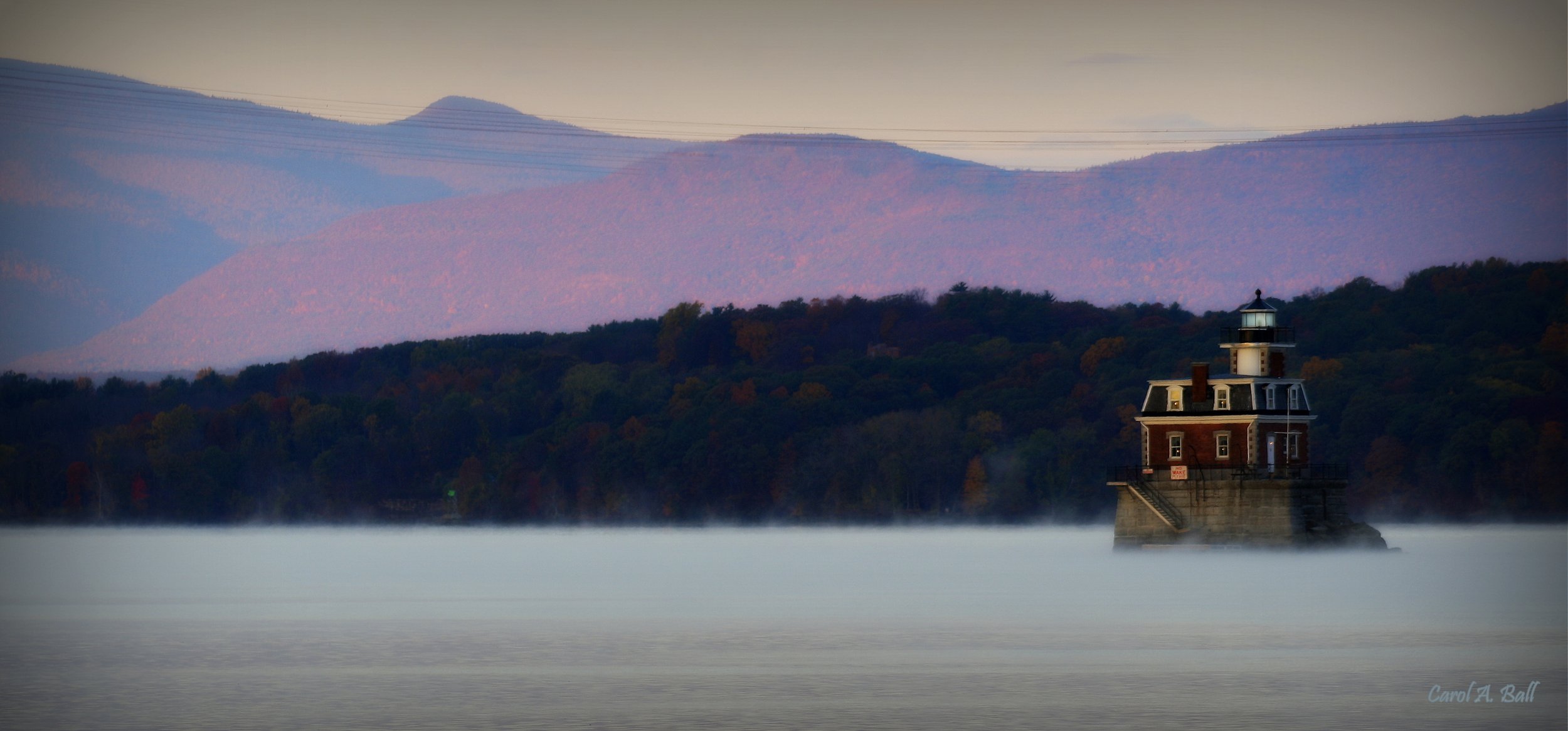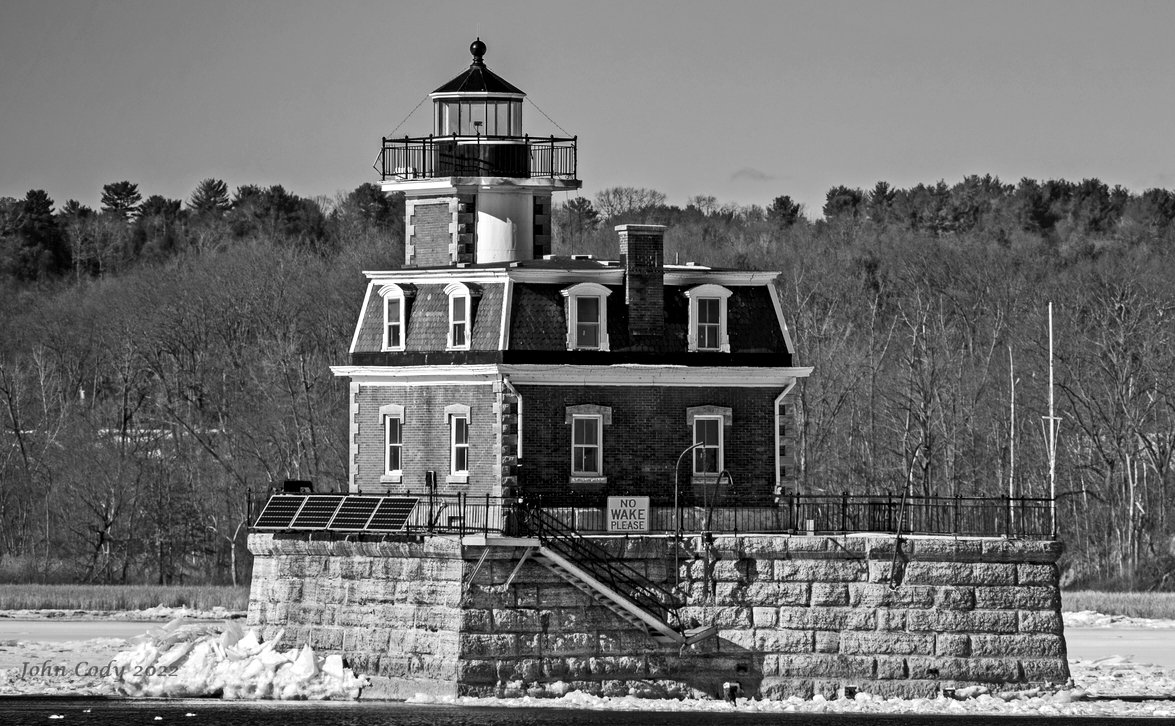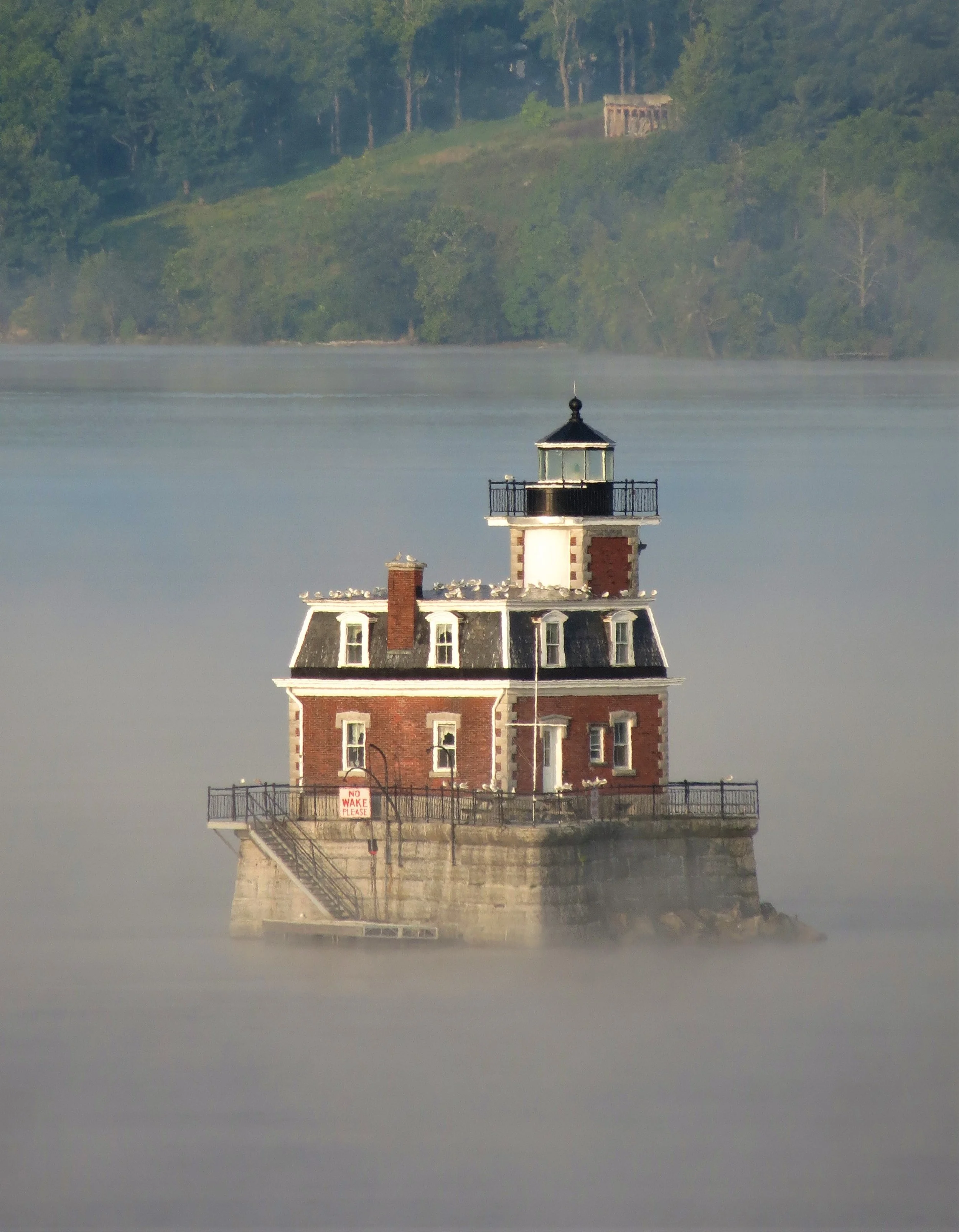
With the opening of the Erie Canal in 1825, boat traffic on the Hudson River increased as it was the fastest way to move goods and people back and forth to the Great Lakes.
In the late 1860’s, hazards created by the Middle Ground Flats opposite the City of Hudson made navigation of the Hudson River at that point extremely dangerous for the busy shipping route. After much petitioning to the Congress of the United States, a survey was completed and an appropriation of $35,000 was approved by Congress in 1872 to build the Hudson City Lighthouse, now known as the Hudson-Athens Lighthouse.
History
Construction began in early 1873, and the lighthouse was completed and put into operation in November 1874. The facility served as a manned lighthouse until the 1950s at which time the lighthouse was automated and a live in keeper was no longer a necessity. Today, the Lighthouse still serves as an aid to navigation, guiding ships safely around Middle Ground Flats.
The Hudson-Athens Lighthouse was operated by the US Lighthouse Service followed by the United States Coast Guard. However, in 1967, then Governor, Nelson A. Rockefeller, established the Hudson River Valley Commission to explore possible uses for the Hudson River Lighthouses. The Commission recommended that the Coast Guard deed over or lease the facilities to public or not-for-profit groups. These groups would then rehabilitate, maintain and operate the facilities for public benefit.
In 1979, the lighthouse was listed on the National Register of Historic Places, named Hudson-Athens Lighthouse “forever and all time,” ending the 2 county controversy. This acted as a combining force for the private citizens of two communities to unite in the effort to retain and maintain the edifice which has played an important role in many lives, young and old, for many years and will continue to do so.
Not until 1982, did any local group seriously attempt to follow through with the recommendations of the Hudson River Valley Commission. In 1982 a group of citizens from Columbia and Greene Counties formed the Hudson-Athens Lighthouse Preservation Committee, operating under the auspices of the Columbia Community Foundation.
Since then, with private donations, public grants, and legislative initiatives, the Hudson-Athens Lighthouse Preservation Committee (now Society) has undertaken the analysis and mitigation of structural, aesthetic, interpretive and public access issues that face the property.
A landmark lease was signed on February 15, 1984. The 20-year lease joined the Columbia Community Foundation (what would become the Hudson-Athens Lighthouse Preservation Society) and the U.S. Coast Guard. It was the first lease signed with a government agency and a private group for a Hudson River Lighthouse. On May 25, 1984, the Hudson-Athens Lighthouse Preservation Committee received a provisional charter allowing them to operate independently of the Columbia Community Foundation. On July 29, 1988, this provisional charter was replaced with a certificate of incorporation.
The Lighthouse title was transferred as part of the Congressional Appropriations Act of 1999. The U.S. Coast Guard officially transferred the deed to the Hudson-Athens Lighthouse Preservation Society on July 3, 2000 making the Hudson-Athens Lighthouse Preservation Society its sole owner.
The Hudson-Athens Lighthouse Preservation Society, Inc. is a private, not-for-profit 501(c) 3 organization with members from Columbia and Greene Counties, surrounding communities and states. The Society is solely responsible for the restoration, preservation, maintenance and operation of the lighthouse and receives no ongoing governmental or private financial support. The lighted beacon remains the responsibility of the U.S. Coast Guard.
-
Henry Hudson was commissioned by the Dutch East India Company on January 8, 1609 to find a passage to the “islands of spicery” that would eliminate the lengthy and expensive voyage around Africa’s Cape of Good Hope. Provided with an 80-ton ship, the Half Moon, and a crew of 20, Hudson embarked on his journey in early April of that year. In vain, Hudson explored the shores and tributaries of both Delaware Bay and Chesapeake Bay searching for a northwest passage.
Not ready to give up quite yet, the crew then sailed north and anchored off the island of Manhattan on September 12, 1609. During the next several days, Hudson sailed up the river that now bears his name, traveling as far as Albany before shallow waters convinced him that this waterway was not the fabled passage either.
-
Over a century later, a town bearing the name Hudson was established along the river of the same name. A group of whalers on Nantucket, fearing that England would reclaim her colonies, decided to move their business inland. After sailing one hundred miles up the Hudson River, they selected a site on the east bank of the river for their new home.
Directly across the river from Hudson, the Village of Athens, which would become a shipbuilding town, was subsequently founded. Together, the cities became an important and busy port on the Hudson River during the nineteenth century.
-
Midstream between the cities was a large mud flat called Middle Ground Flats that was completely submerged at high tide. Many a ship found herself unexpectedly stranded on the flats, prompting Congress to appropriate $35,000 in 1872 for construction of a lighthouse to help ships avoid the obstacle. Work on the lighthouse, officially called the Hudson City Light, began in 1873. Pilings were driven fifty feet into the riverbed and then capped by a granite pier. In order to protect the foundation from winter and spring ice floes, the north end of the base was shaped like the prow of a ship. A two-story, Second Empire style brick structure, similar to the Stepping Stones Lighthouse, was completed atop the granite foundation, and Henry D. Best lit the beacon for the first time on November 14, 1874. The light was shown from a focal plane of 46 feet above the river and was upgraded to a fifth-order Fresnel lens in 1926.
-
Keeper Henry Best performed several rescues during his service. After Henry Best retired, his son, Frank, took over as keeper and continued his father’s practice of helping vessels in distress. In 1912, as Frank Best was performing his duties, he heard a large crash near the lighthouse. He soon discovered the source of the noise; a collision between a tug and the passenger steamship Isabella. Instinctively, Frank jumped into his rowboat and rushed to help. Due to his quick response, Frank was later credited with saving the lives of 11 people.
-
Emil J. Brunner kept the light from 1930 to 1949. For the first seven years, Brunner and his family lived at the lighthouse, but as the children grew older and the school system demanded better school attendance, the family moved into a house in Athens. Each night, Brunner would then row out to tend the light.
In 1939, President Franklin Delano Roosevelt placed the Lighthouse Bureau under the jurisdiction of the United States Coast Guard. Civilian keepers had the opportunity to transfer to the US Coast Guard as Government employees. Brunner did so and continued as keeper.
-
In 1946, Mead Schaeffer, an illustrator traveling north by train from NYC, noticed the lighthouse while entering Hudson. He took this opportunity to capture a still life of the lighthouse through his work. It was on the cover of the Saturday Evening Post December 28, 1946.
The painting shows Brunner rowing to the lighthouse with his son and a Christmas tree on board. The rest of the family (with the artistic license of a few extra children added and a slight alteration to the lighthouse,) is shown standing on the lighthouse deck anxiously awaiting their arrival.
Brunner, the last civilian keeper at the lighthouse, retired in 1949. The light was automated in 1950.
-
The Hudson-Athens Lighthouse Preservation Society (HALPS) was formed in 1982 to preserve and maintain the lighthouse. The U.S. Coast Guard leased the property to HALPS in 1984, while retaining responsibility for the upkeep of the beacon. On July 3, 2000, the title to the lighthouse was transferred to HALPS, a fitting reward for their dedicated efforts. HALPS has recreated the interior of the lighthouse to represent life in the 1930s, when the Brunner family lived there. Many authentic pieces donated by the Brunner family are on display, and the original fog bell, which still has its clockwork mechanism, is mounted outside on the tower.




